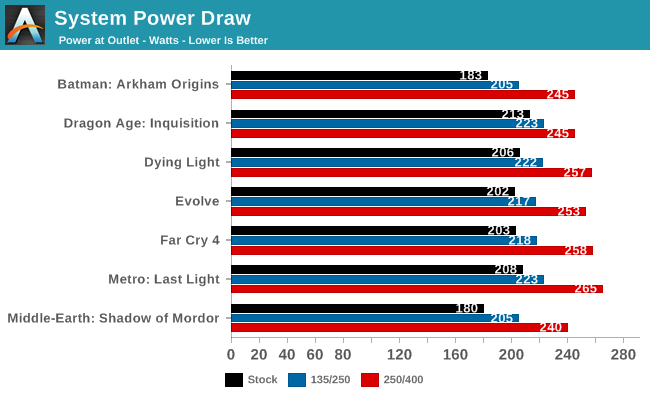Clevo P750ZM: GTX 980M Overclocking Investigated
by Jarred Walton on March 20, 2015 10:00 AM ESTClevo P750ZM: Overclocking Power Requirements
Increasing performance though overclocking will always increase power draw (all other variables being the same), which is part of the concern with overclocking notebooks. On a desktop where you can easily upgrade the power supply and cooling, there are ways to deal with the higher power requirements and increased heat. With a notebook, you’ll want something with a good amount of headroom just to be safe. Thankfully, the P750ZM provides just what we need.

Typically when overclocking components, there’s a point where the power (voltage) requirements start to increase rapidly for increasingly small performance improvements. Our two overclocking targets represent about a 10% and 20% overclock of the GPU core, and both increase the power requirements. However, the aggressive overclock uses almost 20% more power than the moderate overclock on average, which in turn uses a bit less than 10% more power than the stock clocks. Overall, we’re increasing the power draw by nearly 30% for a 20% increase in performance.
Keep in mind that the higher power draw when overclocked isn’t just coming from the GPU – the CPU will end up working harder to feed the faster GPU, so many of the components in the system will use more power. Still, the majority of the power is almost certainly being funneled into the GTX 980M.
The scaling of performance vs. power with our aggressive overclock is actually not too shabby, but it does raise a concern. When it comes to power, this is going to be one of the limiting factors with overclocking certain notebooks. The P750ZM we received from Eurocom includes the beefier 330W AC adapter, so it’s not a problem, but assuming 85% efficiency on the power bricks the 230W AC adapter would be very close to 100% load. Other laptops (e.g. the Gigabyte P35W v3) come with 180W adapters, which we could easily surpass – never mind the difficulty of cooling an overclocked 980M in a slim chassis.
There’s also the question of temperatures, both internal and external, which is what we’ll look at next.










34 Comments
View All Comments
zodiacfml - Saturday, March 21, 2015 - link
Nah, this is no way advisable as longevity and reliability will be sacrificed. It's rare that notebook cooling have been over engineered and mobile GPUs are notorious for deteriorating solder joints which can't be permanently fixed cheaply.smilingcrow - Saturday, March 21, 2015 - link
"Assuming 85% efficiency on the power bricks the 230W AC adapter would be very close to 100% load."I imagine you mean that it's rated for 230W DC output otherwise it would be out of spec as in testing you hit 265W AC. That's ~225W DC output.
waldojim42 - Tuesday, March 24, 2015 - link
I seem to be missing something, who gets power supplies rated based on input wattage, and not output? EVERY laptop power supply I own is rated on the power supplied to the machine. It makes no sense to me to rate the input.radeonex - Saturday, April 11, 2015 - link
I noticed that in this article, for the stock configuration, the GPU temp for the P750ZM stayed below 70 C roughly. However in the full review of the P750ZM, the GPU temp that was shown hovered around 75 C. Can you please comment on the discrepancy?